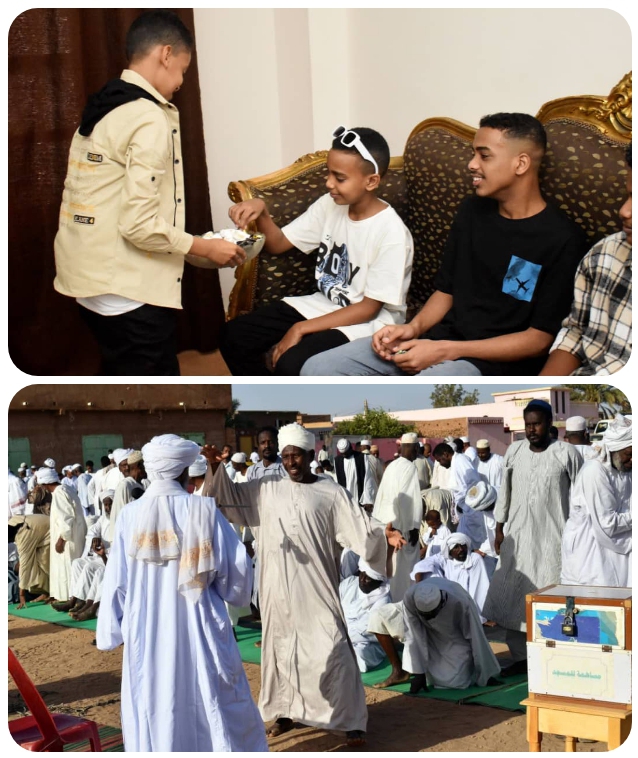Sudanese citizens marked Eid al-Adha amid dire humanitarian and living conditions, as the war enters its third year. What was once a joyful occasion has turned into a time of suffering, exacerbated by mounting economic challenges and ongoing crises. Citizens now face unprecedented hardships, caught between hunger, displacement, and homelessness.
This year, however, residents of Khartoum welcomed Eid in an atmosphere of relative joy. Despite shortages of services and depleted financial savings, the improved security situation and absence of violent scenes allowed many in the capital to enjoy the celebrations and attend Eid prayers. Children rejoiced, and most people moved freely around their neighborhoods without fear—especially after Khartoum became free of the Rapid Support Forces (RSF).
A Call for Peace
More than two years into the conflict, and after the full liberation of the capital from RSF control, many citizens gathered on Eid morning to pray in well-known public squares like the Mawlid grounds and major mosques in Omdurman neighborhoods, as well as in Al-Sahafa, Al-Jarif, Burri, Shambat, and Kafouri in Bahri (North Khartoum). The turnout was significantly larger than in previous Eids, when prayers were often confined to nearby fields.
Mosque preachers focused their sermons on encouraging solidarity and mutual aid during these difficult times, calling for peace and respect for Islamic sanctities. Traditional Eid greetings like “Eid Mubarak” replaced the previously common expressions of concern for safety.
Celebrations and Signs of Hope
Samer Hussein, a resident of Shambat in Khartoum Bahri, said, “For the first time since the war began, we were able to enjoy the unique and special rituals of Eid al-Adha. People revived cherished traditions that had been forcibly abandoned during the 25 months of conflict. Everyone in the neighborhood was able to visit their families and neighbors to exchange greetings in a spirit of forgiveness and reconciliation.” He added, “A hopeful sign this Eid was the restoration of electricity and water in some neighborhoods, which made people feel like they were celebrating twice. I felt overwhelming joy to be with my family, friends, and neighbors after the hardship of staying in displacement shelters.”
Hussein explained that this year’s Eid in Khartoum saw men wearing new white jalabiyas and many donning traditional turbans. Upon returning from prayers with their children, they visited nearby friends and relatives, and the streets were filled with joy and excitement.
Movement and Reconnection
Awab Al-Zain, who returned to Wad Al-Bakhit in Omdurman, said, “I came back with my family after two years. It’s our first Eid in our home since the outbreak of the armed conflict. We found many other families who had come from different parts of Sudan. Life here is calm and stable, and so far, we haven’t faced any major issues.” He added, “We exchanged greetings with indescribable joy, especially after returning home and ending the suffering of displacement. We experienced a different atmosphere, surrounded by neighbors and strangers offering Eid blessings in the streets of Omdurman. Some residents even shared sacrificial meat with the poor.”
He noted that movement around Khartoum was bustling with people and that the level of activity exceeded that of previous Eids during the war.
Gloom and Hardship
In displacement centers across Port Sudan, Atbara, and Al-Qadarif, Eid al-Adha passed like any other day, marked by the sorrow of being away from home and the absence of usual Eid traditions.
Al-Wathiq Al-Sadeeq, residing at the Al-Manal shelter in Damazin, south of Khartoum, said, “Eid celebrations were limited to prayer and chants. Children gathered under schoolyard trees, trying to distract themselves from the harsh living and humanitarian conditions.”
Al-Sadeeq dreams of returning to his home in El Fasher, the capital of North Darfur, despite its partial destruction. He believes living in it, in its current state, would still be better than enduring the hardships of displacement shelters. He remarked, “We had hoped things would improve over time and that peace efforts would succeed, but things have gone in the opposite direction. Now we are certain that returning home has been indefinitely postponed.”
Najwa Al-Taher, residing in a displacement center in Kosti, south of Khartoum, said, “The suffering repeats itself day after day. Those fleeing the horrors of armed conflict have lost the feeling of Eid after being forced to abandon their homes.”
She explained that the difficult economic situation deprived most families of the ability to buy sacrificial sheep, new clothes, or toys for children to bring joy into their lives.
Najwa continued, “Some charitable people donated sacrificial meat and food items to the displaced, but they weren’t enough, given the thousands living in these centers.”
Scattered Across Regions
Outside Khartoum and in Sudan’s conflict-ridden regions, thousands spent Eid day on the move, displaced from towns and areas such as An-Nuhud, Al-Khuwei, Al-Fula, and also Dilling, Al-Hammadi, all under severe humanitarian conditions.
Al-Naeem Othman, who fled from Dilling in South Kordofan, said, “Spending Eid away from home, family, and friends is incredibly painful. There is no joy here on the roads of the unknown, and displaced people can’t even afford to meet their children’s basic needs. Most don’t even feel like celebrating; to many, it was just another day.”
He explained that he fled after enduring bombings and destruction, only leaving once the area became nearly deserted. “I never imagined I would have to leave my home, but I had no choice after the escalation of fighting, the roar of missiles, and drone strikes.”
